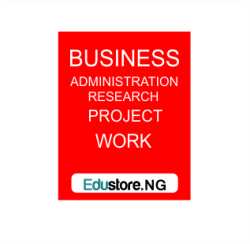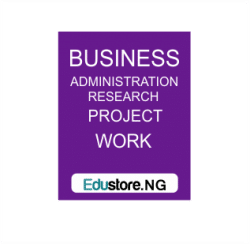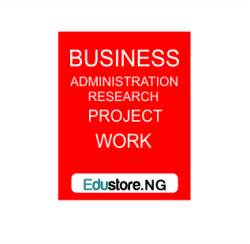ABSTRACT
Delivery of quality service to sustain customers is the major concern of any institution that seeks growth and sustenance. The human resource of an organization has greater impact on the quality of service rendered to customers hence the need for top management to pay attention to human resource systems and the Customer Service of their organizations. The primary purpose of this study is to assess how an organization’s structures affect the Customer Service and consequently its service quality. The study was conducted using the Access Bank in Uyo. The objectives of this study was categorised into general and specific objectives. The general objective was to examine the organizational structures of Access Bank, Uyo and how it impacts Customer Service. The sampling technique employed was the random sampling. A total of two hundred and twenty-seven (227) were used for the study of which a hundred and fifty (150) were customers of the scheme and seventy-seven, staff of the scheme. Primary and secondary data were used for the study, with the primary gathered through field survey and the secondary from the internet, books and the scheme’s office. Data analysis method used was the quantitative method. Correlation and regression analysis was made. From the findings, it was realized that structures and systems are highly recognized by the staff of Access Bank. Also the structures and systems of the scheme are positively to their Customer Service but the structures and systems do not relate significantly to on service quality and it is same with their workers performance too. It was therefore recommended that Access Bank introduce negotiated order to enable other departments give helping hand to each other when the need arises. It was also recommended that the scheme adopt appropriate culture so as to provide satisfactory service to its customers.
CHAPTER ONE
INTRODUCTION
1.1 Background of the Study
An organizational structure defines how activities such as task allocation, coordination and supervision are directed towards the achievement of organizational aims, (Pugh, 1990). Michael (2007) states that organizational structure affects organizational action in two big ways. It provides the foundation on which standard operating procedures and routines rest and also determines which individuals get to participate in which decision-making processes, and thus to what extent their views shape the organization’s actions. A deficiency in an existing organizational pattern implies the need for a change in the existing one.
One of the core values of Organization Development is to provide opportunities for each member of an organization and the organization itself, to develop to their full potentials, (Margulies and Raia, 1972). An intentional planned organization-wide effort can help increase efficiency and effectiveness in an organization so that the Organization may not be only employee oriented but also customer oriented. According to Burke (1982), OD is not just “anything done to better an organization”; but a particular kind of change process which is planned so as to yield a particular kind of end result. The planned change process takes into account a reflection on the Organization, improvement in the system, self analysis and planning. Positive change is necessary for every organization and demands employees’ involvement.
The human resource of an Organization is its valuable assets because they play a vital role in the success or failure and have great impact in its change process as well. For this reason, all levels of management, most importantly management at highest level of an Organization must understand how to work with them so as to achieve customer satisfaction.
Planning strategically, improvement in an existing system of an Organization and successful implementation of an organization’s development plan are necessary functions if well developed can be achieved through Human Resource of an Organization and can consequently lead to an improvement in service quality and customer satisfaction.
Change is a difficult thing to embrace for an Organization’s human resource, but the Organization’s blueprint can be laid aside and through negotiated order, service quality can be achieved. A higher level of effectiveness, efficiency and productivity could be achieved, by such Organizations that use negotiated order.
Organizational change is achieved through systemic learning and development strategy which is geared towards attitudinal change, change in beliefs and importance of values, as well as the current Organizational structure so as to absorb well disruptive technologies, contracting or expanding market opportunities and subsequent challenges and chaos. Several models of change have been designed in OD to address effective change in an Organization which includes Kurt Lewin’s change model and McKinsey 7S Model. Either of these can be used in to improve an Organizations systems and structures.
This study seeks to investigate into the Organizational structures Customer Service and that lead to unsatisfactory service quality of customers of Access Bank, Uyo.
1.2. Problem Statement
Ravasi and Schultz (2006) noted that lager institutions have varied and sometimes contradictory traditions that co-exist and can be attributed to the differing characteristics of the management team available there. These cultures may have negative and positive impacts. More often than not, Organizations prefer clinging to its culture, structures and system since they are more comfortable with them. The culture of an Organization may not always present it as effective and efficient enough in this dynamic or better still, fast changing world.
Public institutions mostly are much comfortable with their Customer Service which impedes advancement, thus, they hardly embrace change, consequently leading to inefficiency and ineffectiveness.
Owing to the fact that service quality create an essential ingredient for establishing and maintaining loyal and profitable customer base (Rust et al, 1995 ; Zeithaml, 2000), National Access Bank, in their outmost best provide maximum satisfaction to their customers yet these customers seem unsatisfied with the effort made. In spite of the number of staff and service persons who help in carrying out its diverse activities to achieve the goals of the Organization, there seem to be heavy work load on them and the systems and structures seemingly create a limit to the help a department can give to another in times of heavy work load on a particular department. This result is longer queues and longer waiting hours by the customers irrespective of age which tends to be quite frustrating.
As McWilliams and Siegel (2001) examined Co-operate Social Responsibility activities and attributes as a differentiation strategy, the scheme in Uyo occasionally send some members of staff to the field to register the less privileged. They at these times give opportunity to others who are due for renewal and those who wish to register with the scheme to do so. At the point of collection, customers wait for several hours at the work premises and sometimes are told their cards are not ready when it is due for collection per the three month period given.
There is also a delegation of the scheme’s authority to persons who play the role of agents between them and the customers in the communities they belong. These agents sometimes make delicate mistakes which create inconveniences for the customers
Generally, being attended to and in a timely manner can be frustrating due to the processes involved. These question therefore arises, what is the Customer Service of the scheme and how does it affect the quality of the service rendered to customers?, what challenges do the staff face in the attending to the large number of customers that troop in day in and day out?
This thesis sought to assess the impact of the Organizational structures on Customer Service using Uyo Access Bank as a case study and its effect on service quality. It also aims at researching into the labour force and customer to interaction which dissatisfies customer. The findings can be used by other schemes to improve their quality of service.
1.3 Objectives of the Study
This research were grouped into two objectives which are general objectives and specific objectives
1.3.1 General Objective
This research seeks to examine the Organizational structures of Access Bank, Uyo and how it impacts workers performance.
1.3.2 Specific Objectives
- To assess the structures and systems of Access Bank of Uyo
- To assess the influence of structures and systems on Customer Service in the Organization
- To assess the effect of structures and systems on service quality of Access Bank, Uyo.
- To identify the human resource systems effect on service quality of the Organization
- To analyse Customer Service on the quality of service at Access Bank
1.4 Research Questions
This research addressed five specific research questions pertaining to customer satisfaction.
- How are the systems and structures of Uyo Access Bank?
- What influence has the structures and systems on Customer Service in the Organization?
- How does Access bank Uyo structures and systems influence service quality?
- How effective is the Human Resource Systems on service quality?
- What influence has Customer Service on the quality of service quality at Access Bank?
1.5 Scope of the Study
The study aimed at assessing the impact of Organizational structures on workers performance. It would have been more objective had all schemes in the country be put on the study.
1.6 Significance of Study
This study would serve as a reference material for the Access Banks in Uyo to improve on the quality of service rendered to their customers. Other Access Banks across the nation can use this research to adopt appropriate measures to improve on quality service as and when the need arises.
The government of the nation can use this to improve on the service rendered by the public service of Nigeria.
1.7 Limitation of the study
The researcher would have loved to cover other Customer Service of other Access Banks in most of the regions in Nigeria and other public institutions in the Uyo but due to time and financial, administrative strict regulations and logistics constraints, the study was limited to only Uyo Access Bank and a few other schemes.
Financing was a major problem because undertaking research to cover schemes in other regions as well as other public institutions in the Municipal required huge sums of money with regards to travel expenses both on the part of the researcher and persons who would help in the data collection exercise.
1.8 Organization of the study
This research was organised in five chapters which are chapters one to five and chapter one basically the introductory aspect of the study.
Chapter one gave a background information about the topic, the problem statement, objectives of the study, research questions, significance of the study, brief methodology, scope of the study, limitations of the study, and Organization of the study.
Chapter two was a review of related literature. This section looked at the literature done on Organizational culture through the web and other published journal. Theories related to Organizational change was talked about. A conceptual framework was drawn.
Chapter three emphasized the methodology used in gathering all forms of data used in the research as well as the Organization’s profile. Chapter four was about data presentation analysis and discussion of findings. Chapter five was the conclusion and looked at the Summary of Findings, Conclusion and Recommendations.
DOWNLOAD COMPLETE WORK
- For Reference Only: Materials are for research, citation, and idea generation purposes and not for submission as your original final year project work.
- Avoid Plagiarism: Do not copy or submit this content as your own project. Doing so may result in academic consequences.
- Use as a Framework: This complete project research material should guide the development of your own final year project work.
- Academic Access: This platform is designed to reduce the stress of visiting school libraries by providing easy access to research materials.
- Institutional Support: Tertiary institutions encourage the review of previous academic works such as journals and theses.
- Open Education: The site is maintained through paid subscriptions to continue offering open access educational resources.






